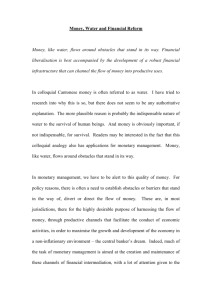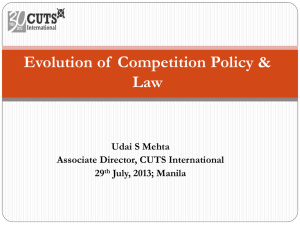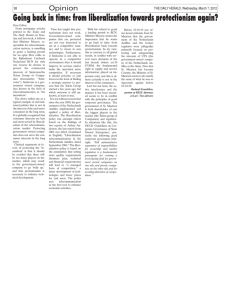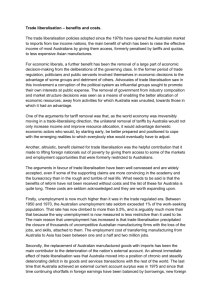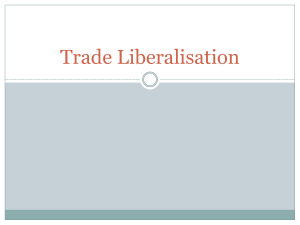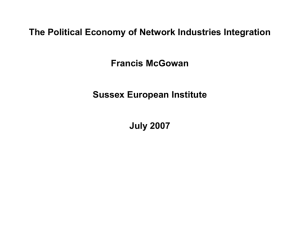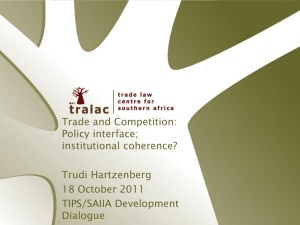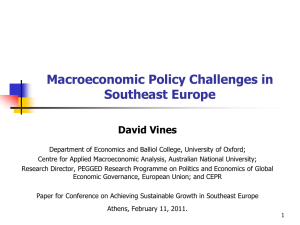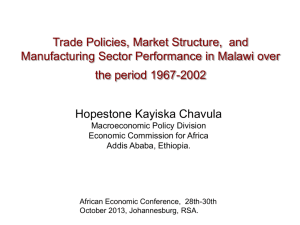The Rhetoric and Reality of Trade Liberalisation in Developing Countries A.P.Thirlwall
advertisement
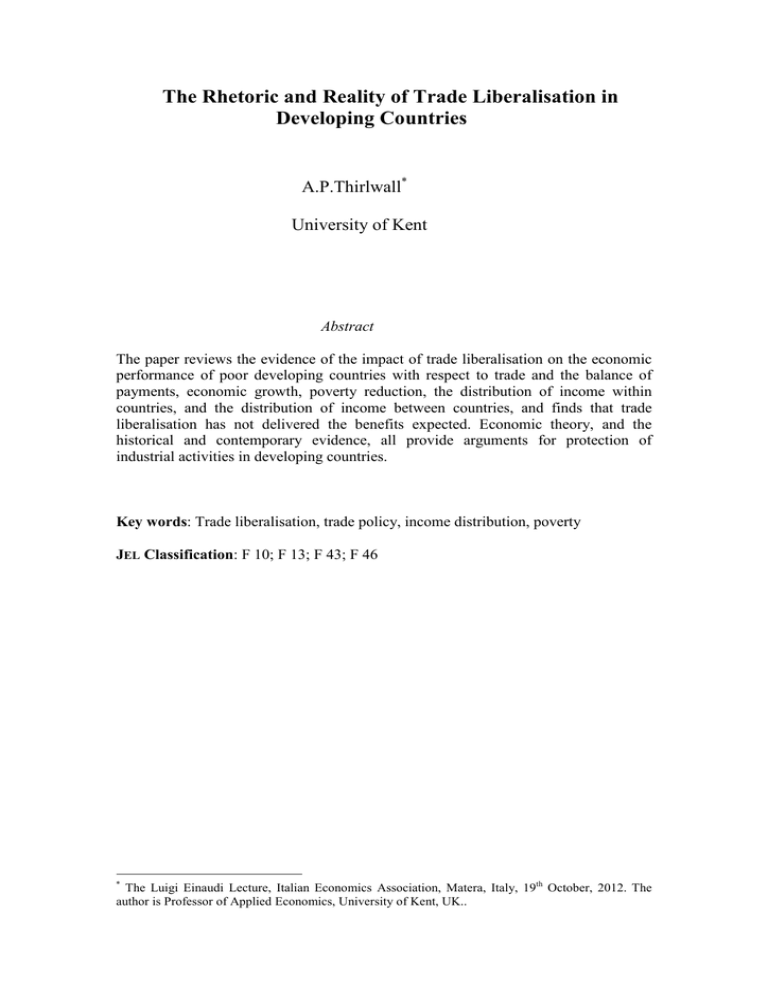
The Rhetoric and Reality of Trade Liberalisation in Developing Countries A.P.Thirlwall* University of Kent Abstract The paper reviews the evidence of the impact of trade liberalisation on the economic performance of poor developing countries with respect to trade and the balance of payments, economic growth, poverty reduction, the distribution of income within countries, and the distribution of income between countries, and finds that trade liberalisation has not delivered the benefits expected. Economic theory, and the historical and contemporary evidence, all provide arguments for protection of industrial activities in developing countries. Key words: Trade liberalisation, trade policy, income distribution, poverty JEL Classification: F 10; F 13; F 43; F 46 * The Luigi Einaudi Lecture, Italian Economics Association, Matera, Italy, 19th October, 2012. The author is Professor of Applied Economics, University of Kent, UK.. The Rhetoric and Reality of Trade Liberalisation in Developing Countries Trade liberalisation has not lived up to its promises. But the basic logic of trade ― its potential to make most, if not all, better off― remains. Trade is not a zerosum game in which those who win do so at the cost of others; it is, or at least can be, a positive-sum game, in which everybody is a winner. If that potential is to be realised, first we must reject two of the long-standing premises of trade liberalisation: that trade liberalisation automatically leads to more trade and growth, and that growth will automatically “trickle down” to benefit all. Neither is consistent with economic theory or historical experience (Stiglitz, 2006). 1. Introduction The last decades have witnessed tremendous pressure on poor developing countries to liberalise their trade. The free trade mantra preached by developed countries and major international development organisations has become like a religion, holding out the promise that if poor countries adopt the faith, they will somehow be ‘saved’. The broad purpose of this paper is to challenge this simplistic view. The paper is based on a review of the vast literature of theory and case studies (including research of my own with colleagues) on the relation between trade liberalisation and economic performance across the world (see Santos-Paulino and Thirlwall, 2004, and Thirlwall and Pacheco-López, 2008), which leads to five general, but important, conclusions. The first is that while there can be static gains from trade (if certain crucial assumptions are met) there is nothing in the theory of trade per se which demonstrates conclusively that trade liberalisation will launch a country on a higher sustainable growth path. Even Jagdish Bhagwati (2001) , the high priest of free trade, is honest about that (see below). Secondly, trade liberalisation has worsened the balance of payments of developing countries, and worsened the trade-off between growth and the balance of payments (at least in Latin America). Thirdly, the evidence is fragile that the economic growth performance of countries that have liberalised extensively is in any way superior to countries that have not. The timing, sequencing and context of liberalisation are of prime importance in determining the impact of liberalisation. Fourthly, the impact of trade liberalisation on reducing world poverty has been minimal and may have increased it. Finally, trade liberalisation has almost certainly worsened the distribution of income between rich and poor countries, and between unskilled wage-earners and other workers within countries, contrary to the predictions of orthodox theory. What really matters for growth performance and poverty reduction is domestic economic policy and growth-supportive institutions. This leads at the end of the paper to a brief discussion of trade strategy for development. 2. What is Wrong with Orthodox Trade Theory? Orthodox trade theory is based on Ricardo’s (1817) law of comparative advantage, and the Heckscher-Ohlin theorem which argues that countries will gain by specialising in the production of goods which use their most abundant factor of production (Heckscher, 1919; Ohlin, 1933). Paul Samuelson (1962) cites Ricardo’s theory of comparative advantage as one of the few laws in economics ‘that is both true and non-trivial’. There are, indeed, static welfare gains to be had by countries specialising in goods in which they have the greatest comparative advantage (or lowest opportunity cost), but two crucial, often-forgotten, assumptions need to be met. The first is that in the process of resources reallocation, full employment is preserved, but this is not guaranteed. If unemployment arises, the welfare gains from greater specialisation may be offset by the welfare losses of unemployment. As Keynes (1930) rightly says ‘free trade assumes that if you throw men out of work in one direction you re-employ them in another. As soon as this link in the chain is broken the whole of the free trade argument breaks down’. The second crucial assumption is 3 that in the process of freeing trade, balance of payments equilibrium is preserved, which is also not guaranteed. In orthodox theory, the balance of payments is assumed to look after itself without affecting output and employment. This was the implicit assumption of the gold standard adjustment mechanism, and is also implicit in the theory of flexible exchange rates. But if trade liberalisation leads to a faster growth of imports than exports and the nominal exchange rate is not an efficient balance of payments adjustment weapon, then output will need to contract to reduce imports, leading to welfare losses. As we shall see later, this has been the experience of many developing countries forced to liberalise prematurely. In fact, the existence of unemployment provides one of the major economic arguments for protection, as outlined in Johnson’s (1964) classic paper on tariffs and economic development. Unemployment means that the social cost of labour is less than the private cost so that a welfare gain is possible by encouraging more domestic employment until the social cost of production is equal to the world price of goods. A subsidy to labour, however, is the first best policy because an equivalent tariff would reduce consumer surplus. Johnson also outlines some of the other classic economic arguments for protection such as the infant industry argument; the externalities argument, and the optimal tariff argument. But Rodrik (1988) is correct that despite the body of trade theory which legitimises protection, the arguments have still not penetrated the vast literature on trade policy in developing countries even though the market imperfections that the arguments reflect are more serious in developing countries than in developed countries. 4 As well as potential static gains from trade (although not guaranteed, and in any case small (see Dowrick, 1997)) there are also possible dynamic gains which arise through the greater flow of ideas, new knowledge, investment and economies of scale if the domestic market for output is small. The dynamic effects of trade, however, depend primarily on what countries specialise in; whether natural resource activities or manufacturing. John Stuart Mill (1848) pointed this out in the 19th century, and Stiglitz (2006) today makes the same enduring point: Without protection, a country whose static comparative advantage lies in, say agriculture, risks stagnation; its comparative advantage will remain in agriculture, with limited growth prospects. Broad-based industrial protection can lead to an increase in the size of the industrial sector which is, almost everywhere, the source of innovation; many of these advances spill over into the rest of the economy as do the benefits from the development of institutions, like financial markets, that accompany the growth of an industrial sector. Moreover, a large and growing industrial sector (and the tariffs on manufactured goods) provide revenues with which the government can fund education, infrastructure, and other ingredients for broad-based growth. In other words, if trade is to be an engine of growth, poor countries need to acquire new comparative advantage in goods that have favourable production and demand characteristics. Structure matters for economic growth. This is recognised in ‘new’ trade theory pioneered by Krugman (1984, 1986) in the 1980s, who shows there is a case for protecting industries with spillovers and externalities, and for using import substitution for export promotion. In most standard growth models, however, the effect of trade on growth is ambiguous. For example, in the canonical neoclassical Solow model (1956), trade cannot affect the steady-state growth rate, because it is treated as an exogenous constant. Only in the ‘new’ growth theories of, for example, Grossman and Helpman (1991a, 1991b) does trade have the potential to raise the growth rate permanently through learning and spillover effects, but they have to be 5 continuous. Bhagwati (2001), the most ardent advocate of free trade, even for poor developing countries, frankly admits: Those who assert that free trade will ---lead necessarily to greater growth either are ignorant of the fine nuances of the theory and the vast quantity of literature to the contrary on the subject at hand or are nonetheless basing their argument on a different premise; that is, that the preponderant evidence on the issue (in the post-war period) suggests that free trade tends to lead to greater growth after all. In fact, where theory includes several models that can lead in different directions, the policy economist is challenged to choose the model that is most appropriate to the reality she confronts. And I would argue that, in the present instance, we must choose the approach that generates favourable outcomes for growth when trade is liberalised. The issue is empirical, but certainly history is not on the side of the free-traders. None of the now-developed countries transformed their economies on the basis of laisserfaire, laissez-passer. Great Britain started to protect and foster industries as early as the late 15th century under Henry VII, and did not start dismantling the structure of protection until the repeal of the Corn Laws in 1848. From then on Great Britain preached free trade, but it had already attained technological superiority in the world economy, and such preaching, as List (1865) remarked, was like ‘kicking away the ladder’. The United States followed Great Britain’s protectionist route at the end of the 18th century under the influence of the Treasury Secretary, Alexander Hamilton who, in 1791, first coined the term ‘infant industry’. Adam Smith’s advice to the United States in his Wealth of Nations (1776) was to pursue free trade: Were the Americans, either by combination or by any other sort of violence, to stop the importation to European manufactures, and, by thus giving a monopoly to such of their own countrymen as could manufacture the like goods, divert any considerable part of their capital into this employment, they would retard instead of accelerating the further increase in the value of their annual produce, and would obstruct instead of promoting the progress of their country towards real wealth and greatness. 6 If the United States had followed Smith’s advice, it would have remained an economic backwater instead of becoming the richest country in the world based on high productivity in industry. The same can be said of modern-day economic giants, such as Japan and South Korea, whose comparative advantage once lay in rice, but who, through selective protection, import substitution, export promotion and directed credit, transformed themselves into industrial power-houses (see Chang, 2005). The newly industrialising countries of South-East Asia, and particularly China, are pursuing the same route to development; transforming their industrial structure through deliberate policy intervention, and are growing fast as a consequence. Stiglitz (2006) is right when he says that ‘economists who promise that trade liberalisation will make everybody better off are being disingenuous. Economic theory (and historical experience) suggests the contrary’. All we know is that as countries get richer they dismantle trade restrictions, not that they get richer because they liberalise trade. The issue for poor developing countries today is not whether to protect, but how to protect in order to ensure the dynamic efficiency of their nascent industrial activities. 3. Trade Liberalisation and Trade Performance The main purpose of trade liberalisation is to promote, or allow, the most efficient allocation of a country’s resources to maximise its welfare. We have already criticised the static nature of orthodox trade theory, and outlined some of its limiting assumptions, but what has been the effect of trade liberalisation in practice on countries’ trade performance, and ultimately on the growth of living standards? This requires detailed statistical analysis. Research on export performance before and after liberalisation gives mixed results depending on the context in which trade 7 liberalisation takes place, particularly the domestic economic policy being pursued and world economic conditions. Also, in econometric studies, results differ according to the methodology used and how liberalisation is measured. The most comprehensive recent study is that of Santos-Paulino and Thirlwall (2004) who take a panel of 22 developing countries from the four ‘regions’ of Africa, Latin America, East Asia and South Asia that undertook significant trade liberalisation during the period 19721997. Trade liberalisation is measured by two indicators: firstly by duties on exports, and secondly by a dummy variable taking the value of one in the year when trade liberalisation took place (and continued) and zero otherwise. Panel data and time series/cross section estimation techniques are then applied to the determination of export growth using a conventional export growth equation of the form: xt = a o + a1 (rert ) + a 2 ( z t ) + a3 (d xt ) + a 4 (libt ) (1) where x is the growth of export volume; rer is the rate of change of the real exchange rate; z is the growth of world income; dx is the duty on exports; lib is the liberalisation dummy, and t is time. Depending on the estimation technique used, the central estimate is that trade liberalisation has raised export growth by approximately two percentage points, or by one-quarter compared to the pre-liberalisation export growth rate. The estimated coefficient on the export duty variable is negative, but small (roughly -0.2). The coefficient on the liberalisation dummy variable is consistently in the range 1-2 taking the full sample of 22 countries, but the quantitative effect (shown in brackets) differs between the four regions: Africa (3.58); South Asia (2.54); East Asia (2.42), and Latin America (1.66). 8 For a country’s overall economic performance to improve, however, it is not enough for export growth to accelerate. Export growth must be shown to outpace import growth, otherwise balance of payments difficulties will arise. In the literature on trade liberalisation, very little attention has been paid to import growth, or to the balance between export growth and import growth. This is a serious weakness of trade liberalisation studies, but is a reflection of the fact that in orthodox trade and growth theory the balance of payments is either assumed to look after itself, or deficits are regarded as a form of consumption smoothing and have no long run effect on real variables. Country studies by Melo and Vogt (1984) for Venezuela; Mah (1999) for Thailand, and Bertola and Faini (1991) for Morocco all show a significant impact of trade liberalisation on import growth and on the sensitivity of imports to domestic income growth, but the most detailed study is that by Santos-Paulino and Thirlwall (2004) who take the same 22 countries as for export growth and test three hypotheses: (i) trade liberalisation, measured by a shift dummy variable (lib), significantly increases import growth; (ii) reductions in tariffs (dm) raise import growth, and (iii) a more liberal trade regime increases the income and price elasticities of demand for imports (measured by interacting the liberalisation dummy with the growth of income and real exchange rate variables, liby and librer, respectively). The import growth equation specified to capture these effects is: mt = bo + b1 (rert ) + b2 ( y t ) + b3 (d mt ) + b4 (libt ) + b5 (liby t ) + b6 (librert ) (2) The results may be summarised as follows. Trade liberalisation itself, controlling for all other factors, has increased the growth of imports by between 5 and 6 percentage points, which represents a near doubling of the pre-liberalisation import growth. The independent effect of tariff cuts has been to raise the growth of imports by between 2 and 5 p.p. for a one p.p. cut in tariff rates. Liberalisation has increased the elasticity of 9 imports to both domestic income and exchange rate changes by between 0.2 and 0.5 p.p. In Pacheco-López and Thirlwall (2006) the direct effect of trade liberalisation on the income elasticity of demand for imports is estimated for 17 Latin American countries over the period 1977 to 2002 using a simplified version of equation (2): mt = co + c1 (rert ) + π 1 ( y t ) + π 2 (liby t ) (3) where π1 is the income elasticity of demand for imports in the pre-liberalisation period and (π1 + π2) is the income elasticity in the post-liberalisation period. We find an increase of 0.55 from 2.08 to 2.63, which more or less offsets the increase in export growth post-liberalisation, leaving the GDP growth rate of countries consistent with balance of payments equilibrium virtually unchanged. This increase in the income elasticity of demand for imports in Latin America as a result of trade liberalisation is confirmed using the technique of rolling regressions taking 13 overlapping periods starting from 1977-90 and ending in 1989-2002. The estimated income elasticity starts at 2.04 and ends at 2.82, giving an annual trend rate of increase of approximately 0.04 p.p. If trade liberalisation raises the growth of imports by more than exports, or raises the income elasticity of demand for imports by more than in proportion to the growth of exports, the balance of trade (or payments) will worsen at a given growth of output, unless the currency can be manipulated to raise the value of exports relative to imports. Surprisingly, very little research has been done on the balance of payments effect of trade liberalisation. The first major studies were by Parikh for UNCTAD (1999) and for WIDER (Parikh, 2002). The first study examined 16 countries over the period 1970-95, with the main result that trade liberalisation seems to have worsened 10 the trade balance by 2.7 per cent of GDP (which is substantial). The second study extends the analysis to 64 countries, with the general conclusion: the exports of most of the liberalising countries have not grown fast enough after trade liberalisation to compensate for the rapid growth of imports during the years immediately following trade liberalisation. The evidence suggests that trade liberalisation in developing countries has tended to lead to a deterioration in the trade account Santos-Paulino and Thirlwall (2004) take the same sample of 22 developing countries as for the impact of trade liberalisation on export and import growth previously discussed, and estimate the following equation: TBt BPt and = d 0 + d1 ( z ) + d 2 ( yt ) + d 3 (rert ) + d 4 (d xt ) + d 5 (d mt ) + d 6 (ttt ) + GDPt GDPt (4) + d 7 (libt ) + d 8 (libyt ) where TB/GDP is the trade balance to GDP ratio, and BP/GDP is the balance of payments to GDP ratio; tt is the terms of trade, and the other variables are as defined in equations (1) and (2). The equations are estimated using panel data techniques over the period 1976-98. The most important result is that the switch to a more liberal trading regime has worsened, on average, the trade balance by 2 per cent of GDP (which is similar to the Parikh estimate), and the balance of payments by 1 per cent of GDP. For a group of 17 Least Developed Countries over the period 1970-2001, Santos-Paulino (2007) finds a deterioration in the trade balance ratio of 4 per cent of GDP. In the 17 Latin American countries mentioned earlier, there is a deterioration in the trade balance of between 1.3 and 2.3 per cent of GDP depending on the method of estimation used (whether a panel, or time-series/cross-section, estimator, using as 11 control variables the first three variables in equation 4). All these results show that trade liberalisation has impacted unfavourably on the trade balance and current account balance of liberalising countries. Such a deterioration, if it cannot be financed by sustainable capital inflows, may either trigger a currency crisis or necessitate a severe deflation of domestic demand (and therefore growth) to control imports. As UNCTAD (2004) says in its Least Developed Countries Report 2004: ‘this critical [balance of payments] constraint on development and sustained poverty reduction is conspicuously absent in the current debate on trade and poverty’; and also, it may be added, in the debate on the wisdom of rapid trade liberalisation in poor vulnerable countries. Indeed, the ultimate test of successful trade liberalisation, at least at the macro-level without regard to distributional effects, is whether it lifts a country onto a higher growth path consistent with a sustainable balance of payments; or, in other words, whether it improves the trade-off between growth and the balance of payments, as illustrated in Figure 1. Figure 1 The Trade-Off between Growth and the Balance of Payments BP/GDP + 0 b + GDP growth (y) ― a ― 12 On the vertical axis is measured the ratio of the balance of payments to GDP, and on the horizontal axis, the growth of GDP. The solid-line curve gives the negative tradeoff curve showing how the balance of payments deteriorates as growth accelerates. The curve is drawn to represent a serious situation where the balance of payments is in deficit (point a) even at zero growth. The objective of trade policy should be to shift the curve upwards, to, say, point b on the horizontal axis so that some positive GDP growth is possible without running into balance of payments difficulties. Pacheco-Lopez and Thirlwall (2007) estimate this trade-off curve (using the trade balance/GDP ratio as the dependent variable) for 17 Latin American countries over the period 1977 to 2002 using pooled data (giving 425 observations) to see whether trade liberalisation has resulted in a positive shift. Fitting a linear (for simplicity) regression line, without controlling for liberalisation, gives the result (t-statistics in brackets): TB/GDP = –3.203 – 0.315 y (– 6.3) (5) (–3.3) The curve cuts the vertical axis in the negative quadrant, which is serious. The average GDP growth for the sample as a whole is 2.76 per cent per annum, with an average trade deficit of -4.69 per cent of GDP. When a liberalisation dummy is included in the equation, the result shows a negative, not positive, effect i.e. TB/GDP = –1.387 – 0.258 y – 3.610 (lib) (–2.1) (–2.7) (6) (–4.2) 13 The pre-liberalisation deficit at zero growth is -1.387, and the post-liberalisation deficit is (-1.387) + (-3.610) = -4.997. Liberalisation has worsened the trade-off by 3.6 percentage points. Controlling for changes in the real exchange rate and world income growth reduces the unfavourable impact to -2.0 p.p., but this is still significant. 4. Trade Liberalisation and Growth Performance While it is true that trade liberalisation has improved export performance, liberalisation and export growth are not the same, and should not be confused. As Stiglitz (2006) notes: Advocates of liberalisation cite statistical studies claiming that liberalisation enhances growth. But a careful look at the evidence shows something quite different… It is exports –not the removal of trade barriers– that is the driving force of growth. Studies that focus directly on the removal of trade barriers show little relationship between liberalisation and growth. The advocates of quick liberalisation tried an intellectual sleight of hand, hoping that the broad-brush discussion of the benefits of globalisation would suffice to make their case. The study of Latin America discussed above is the only one I know that examines the impact of liberalisation on the trade-off between growth and the balance of payments, but there are several time series and cross section studies of the relation between liberalisation and GDP growth on the one hand and trade openness and GDP growth on the other (although trade openness is not the same as liberalisation). The studies give mixed results, but it can definitely be said that the extravagant claims of the protrade liberalisers look hollow when compared with the evidence. Early work by Edwards (1992, 1998) and Dollar (1992) showing a positive relation between openness (or the outward orientation of countries) and growth performance was heavily criticised by Rodriguez and Rodrik (2000) on methodological grounds and for 14 lack of robustness. Similar work by Dollar and Kraay (2004) on ‘globalisation’ and economic growth was likewise criticised by Dowrick and Golley (2004) who show that the faster growth of Dollar and Kraay’s sample of ‘globalising’ countries is entirely due to the fast growth of China and India. Even more telling, the so-called ‘globalising’ countries identified were not the most open or liberalised. Another major study of trade orientation and growth is that by Sachs and Warner (1995) who found that more open economies over the period 1979-89 grew 2.44 p.p. faster than economies identified as closed. Wacziard and Welch (2008) extend the Sachs-Warner study into the 1990s with more countries, and find that their result is not robust; there appears to be no significant effect of openness on growth performance. Greenaway, Morgan and Wright (1998, 2002) examine the relationship between trade liberalisation and GDP growth using an impact dummy variable for the year of liberalisation in a sample of up to 73 countries over the period 1975-93, and find a Jcurve effect with growth first deteriorating and then improving. There is no indication, however, of how long the lagged-growth effect lasts. Rodriguez and Rodrik (2000) conclude their evaluation of studies of trade orientation and economic growth by saying that indicators of openness used are either poor measures of trade barriers or are highly correlated with other determinants of domestic performance. All studies should therefore be treated with great caution. They are particularly concerned that the priority given to trade policy reform has generated expectations that are unlikely to be met, and may preclude other, institutional reforms which would have a greater impact on economic performance. Trade liberalisation, in other words, cannot be regarded as a substitute for a comprehensive trade and development strategy. To quote Rodrik (2001): Deep trade liberalisation cannot be relied upon to deliver high rates of economic growth and therefore does not deserve the high priority 15 it typically receives in the development strategies pushed by leading organisations. 5. Poverty and Income Inequality within Countries At this moment in time, nearly 1.4 billion of the world’s population live on less than US$1.25 a day (the World Bank’s official poverty line), and 2.6 billion live on less than $2 a day (Chen and Ravallion, 2008). In other words, over one-third of the world’s population lives in absolute poverty. Advocates of trade liberalisation promise that the freeing of trade will lift people out of poverty. The former European Trade Commissioner, Peter Mandelson, wrote in The Guardian newspaper (3rd October 2008) that globalisation is the greatest engine of poverty reduction the world has ever seen. If he had looked at the facts, however, he would see that outside of China the absolute number of people in poverty has not decreased. The number on less than $2 a day increased from 1.5 billion in 1981 to 2 billion in 2005, and the number on less than $1.25 a day stayed roughly the same at just over 1 billion. The reduction in the total numbers living on less than $1.25 a day is entirely due to the reduction of poverty in China since the early 1980s, but this was the result of agricultural reforms not trade liberalisation. Winters et al. (2004), in their survey of trade liberalisation and poverty, claim that ‘theory provides a strong presumption that trade liberalisation will be poverty alleviating in the long run and on average’. This is simply not true, because, as we have seen, the theory of trade liberalisation says nothing definite about economic growth. The impact of trade liberalisation on poverty depends on its effects on employment and prices. Trade liberalisation can easily cause poverty by throwing people out of work. For example, since the NAFTA agreement was signed between the US, Canada and Mexico in 1994, two million Mexican maize farmers have lost their jobs because they cannot compete with subsidised maize from 16 the US. Trade liberalisation can provide new opportunities in the export sector, but only if the sector is prepared. The statistical research on the relation between trade liberalisation and poverty is very inconclusive. The most comprehensive study is by Ravallion (2006) who takes 75 countries where there have been at least two household surveys on poverty, and runs a simple regression of the percentage change in the poverty rate on the percentage change in the ratio of trade to GDP (as a proxy for liberalisation). There is a statistically significant negative coefficient of 0.84, but the correlation is very fragile. For example, controlling for initial conditions makes the relation insignificant, and adding other control variables makes no difference. Ravallion concludes ‘it remains clear that there is considerable variation in the rates of poverty reduction at a given rate of expansion of trade volume’. Equally, however, ‘based on the data available from cross-country comparisons, it is hard to maintain the view that expanding trade, in general, is a powerful force for poverty reduction in developing countries’. At the same time as the absolute numbers in poverty have been increasing, the distribution of income within poor countries has also been widening, contrary to the orthodox predictions of the Hecksher-Ohlin (and Stolper-Samuelson, 1941) theorems. Golberg and Pavcnik (2007), in their survey of the distributional effects of globalisation in developing countries, say: ‘while inequality has many different dimensions, all existing measures for inequality in developing countries seem to point to an increase in inequality which in some cases is severe’. The major cause of income inequality is wage inequality between skilled and unskilled workers. Orthodox trade theory predicts a narrowing of wage inequality in poor countries because their comparative advantage should lie in the production and export of goods 17 using abundant unskilled labour. This narrowing has not happened for four main reasons: first, trade-related, skill-biased technical change; secondly, competition between poor countries; thirdly, flows of foreign direct investment adding to the demand for skilled labour, and finally in some cases, depressed demand for unskilled labour where trade liberalisation has caused balance of payments difficulties (see Arbache et al. 2004 for a case study of Brazil). By far the most detailed study of the impact of trade liberalisation on the distribution of income is that by Milanovic (2005a). First, in his introductory survey of the existing literature, he remarks: The conclusions run nearly the full gamut, from openness reducing the real income of the poor to openness raising the income of the poor proportionately less than the income of the rich to raising both the same in relative terms. Note, however, that there are no results that show openness reducing inequality; that is, raising the income of the poor more than the income of the rich ―let alone raising the absolute income of the poor by more. Milanovic’s own research takes 321 household surveys from 95 countries in 1988, and 113 countries in 1993 and 1998 covering 90 percent of the world’s population. Income inequality is measured, not by a summary statistic such as the Gini ratio or Theil index, but by the income of the ith decile of the population relative to the mean level of income of the whole population. For each decile, income inequality is then related to trade openness measured by the ratio of total trade to GDP, and also to openness interacted with the level of income to test whether the effect of openness on inequality varies with the level of income. A regression is run for each of the ten deciles using the same independent variables. Two striking results emerge. Firstly, increased openness reduces the income share of the bottom six deciles. Secondly, the adverse effect of openness on inequality is less the higher a country’s per capita 18 income. The turning point for the poor to benefit from increased trade is approximately US$7,500 at 1990 prices. Barro (2000) and Spilimbergo et al. (1999) also find openness worsens income inequality up to a certain point and then the effect diminishes. Milanovic concludes: ‘openness would therefore seem to have a particularly negative impact on poor and middle income groups in poor countries – directly opposite to what would be expected from the standard Hecksher-OhlinSamuelson framework’. The contrary conclusion to the above studies of Dollar and Kraay (2002, 2004) that ‘growth is good for the poor’ arises from their unusual procedure of measuring trade in nominal US dollars, but measuring GDP at purchasing power parity (PPP). Since GDP at PPP is much higher than in nominal dollars, this considerably understates the ratio of trade to GDP in poor countries. For example, China’s exports as a share of GDP measured at PPP are only 7 per cent compared to 26 per cent if both trade and GDP are measured in nominal dollars. It is this latter ratio that affects the income distribution, and which should be used in studies of trade and income distribution. 6. International and Global Inequality Not only has the distribution of income within poor countries been increasing over time, but also the distribution of income between poor and rich countries. Again, this contradicts the prediction of orthodox neoclassical theory (Solow, 1956) which argues that because the productivity of capital should be higher in poor capital-scarce countries than in rich capital-saturated countries, poor countries should grow faster than the rich leading to a convergence of living standards across the world. There are many non-orthodox models to explain divergence, associated with the names of 19 Myrdal (1957), Hirschman (1958), Kaldor (1970) and various Marxist writers, but nonetheless the orthodoxy prevails despite the evidence. The measurement of international inequality takes each country’s average per capita income as a single unit, regardless of the distribution of income within countries, and a Gini ratio can be calculated either unweighted or weighted by population. Global inequality, by contrast, not only measures inequality between countries but also within countries as well, giving a higher figure. The most recent calculations of the Gini ratio of international inequality by Milanovic (2005b), and of global inequality by Milanovic (2005b), Bourguignon and Morrisson (2002) and Sala-i-Martin (2002) are shown in Table 1. Table 1 A Comparison of Gini Ratios International Inequality (1) Year 1820 1870 1890 1913 1929 1938 1952 1960 1978 1988 1993 1998 2000 Unweighted Population weighted 0.20 0.29 0.31 0.37 0.35 0.35 0.45 0.46 0.47 0.50 0.53 0.54 0.12 0.26 0.30 0.37 0.40 0.40 0.57 0.55 0.54 0.53 0.52 0.50 Global (or World) Inequality Bourginon and Milanovic Sala-i-Martin Morrisson (2005b) (2002) (2002) 0.50 0.56 0.59 0.61 0.62 0.64 0.64 0.66 0.62 0.65 0.64 0.66 (1992) 0.66 (1970) 0.65 0.64 0.63 0.63 Sources: (1) Adapted from Milanovic (2005b), Table 11.1. The unweighted Gini ratio for international inequality shows a steady historical rise from 1820, and also in the post-war period of trade liberalisation from 1952. The population-weighted Gini ratio of international inequality shows a slight decline in recent years due to the fast growth of populous countries such as China and India. If 20 China is taken from the sample, the population-weighted Gini ratio is also shown to rise. The Gini ratio for global inequality has increased over time but has been relatively static in recent years because while between-country inequality (populationweighted) has fallen slightly, income inequality within countries has increased, particularly in China between the rural and urban sectors. The question is: how much of this rising and persistent inequality across the world is due to trade liberalisation? It is not easy to answer this question, but attempts can be made. One methodological approach is to interact a measure of trade openness with the level of per capita income (PCY) to test whether the impact of openness varies with the level of development. This is what Dowrick and Golley (2004) do, taking over 100 countries for two separate time periods, 1960-80 and 1980-2000, and regressing the growth of PCY on (i) trade as a percent of GDP; (ii) an interaction term of trade openness and a country’s level of PCY; (iii) a dummy variable for specialisation in primary products, measured as more than 50 per cent of exports; and (iv) a number of control variables. Separate regressions are also run for developed and less developed countries. For the first period 1960-80, a higher trade share of one percentage point (p.p.) is associated with 0.11 per cent faster growth, and the poorer the country, the slightly greater the benefit from openness, meaning that trade was a force for convergence. But for the second period, 1980-2000, this result is reversed. The impact of the trade share on the growth of PCY is now negative (-0.072) and the interaction term with the level of PCY is positive (+0.009) indicating that poor countries suffered from trade openness more than rich countries, leading to divergence. Dividing the 1980-2000 sample of countries into 33 poorest countries and the rest shows no significant effect of the trade share on growth in the poorest 21 countries, but the richer countries gained about 0.012 per cent growth for a one p.p. increase in the trade share. Specialisation in primary products had a strong negative effect on growth in the 1980-2000 period, reducing it on average by nearly one per cent; and the impact was even stronger in the poor country group ―a difference of 1.76 per cent. Dowrick and Golley’s conclusion is that ‘trade has promoted strong divergence in productivity [between countries] since 1980’. 7. Trade Strategy for Development So what trade strategy should poor countries pursue? The overriding objective must be to acquire dynamic comparative advantage. For this, the private sector of an economy needs the support of the government in the form of incentives and various types of ‘protection’ to mitigate investment risks. It is one thing to argue against antiexport bias; it is another to argue that poor countries should abandon all forms of protection of domestic industry. Improved market access to developed countries for poor country exports merely perpetuates static comparative advantage. As Rodrik (2001) argued in the lead-up to the recent (failed) Doha round of trade negotiations ‘the exchange of reduced policy autonomy in the South for improved market access in the North is a bad bargain where development is concerned’. Poor countries need time and policy space to nurture new (infant) industrial activities as developed countries did historically, and as many newly industrialising economies still do today. As Hausmann and Rodrik (2003) say in their important work on the concept of ‘self discovery’: the fact that the world’s most successful economies during the last few decades prospered doing things that are most commonly associated with failure (e.g. protection) is something that cannot easily be dismissed 22 Hausmann and Rodrik’s argument is that there is much randomness in the process of a country discovering what it is best at producing, and a lack of protection reduces the incentive to invest in discovering which goods and services they are. Poor, labour abundant economies have thousands of things they could produce and trade, but in practice their exports are highly concentrated. Sometimes, over 50 per cent of exports are accounted for by less than ten products. Bangladesh and Pakistan are countries at similar levels of development, but Bangladesh specialises in hats and Pakistan in bed sheets. This specialisation is not the result of resource endowment; it is the result of chance choice by enterprising entrepreneurs who ‘discovered’ (ex-post) where relative costs were low. Other ‘chance’ investments include cut flowers in Colombia for export to North America; camel cheese in Mauritania for export to the European Union; high-yield maize in Malawi, and squash in Tonga. The policy implications of the Haussmann and Rodrik observation and model are that governments need to encourage entrepreneurship and invest in new activities ex-ante, but push out unproductive firms and sectors ex-post. Intervention needs to discriminate as far as possible between innovators and imitators. Normal forms of trade protection turn out not to be the ideal policy instruments because they do not discriminate, and earn profits only for those selling in the domestic market. Export subsidies avoid antiexport bias, but still do not discriminate between the innovators and the copycats, and in any case are illegal under the rules of the WTO. The first-best policy is public sector credit or guarantees which can discriminate in favour of the innovator, and be used as a ‘stick’ if firms do not perform well. There is much that the international community can also do to promote trade for development, as opposed to pursuing trade liberalisation for its own sake. The whole 23 world trade system works against the majority of poor developing countries, firstly because of their dependence on primary commodities (the ‘curse’ of natural resources) and low value-added manufactures; secondly because the ‘rules of the game’ governing trade between rich and poor countries are rigged and biased in favour of the rich, and thirdly because the agenda for trade reform is largely set by the rich developed countries. The only permanent solution to primary-commodity dependence is structural change which requires the establishment of new, nontraditional industries; but this is what the rich developed nations are hostile to. They want free access to poor countries’ markets, while continuing to protect their own. The most recent example of this is the ongoing debate between the European Union (EU) and the African, Caribbean and Pacific (ACP) countries over Economic Partnership Agreements (EPAs) to replace the trade preferences that the ACP countries used to enjoy under the Lomé Convention. The EU is insisting that poor developing countries reduce restrictions on imports of manufactured goods and service activities in return for continued access to the EU market for their agricultural products. The EU is refusing to look at alternatives to free trade EPAs, but by its own admission it concedes that EPAs could lead to the collapse of the manufacturing sector in many poor countries. As Stiglitz (2006) remarks in his powerful book Making Globalisation Work, ‘the US and Europe have perfected the art of arguing for free trade while simultaneously working for trade agreements that protect themselves against imports from developing countries’. If developed countries really wanted to help poor developing countries they could reduce and eliminate tariffs and barriers against all their goods. Oxfam (2002) estimates that trade barriers against developing countries’ goods cost about $100 billion a year; as much as the level of official development assistance. In addition, developing countries might be allowed ‘infant 24 country protection’, which would be equivalent to a currency devaluation, but have the advantage of raising revenue for spending on public goods. One of the severe drawbacks of tariff reductions in poor countries is a loss of tax revenue. If trade is to promote development, the World Trade Organization (WTO), that now governs world trade, needs radical reform and rethinking. The Agreement establishing the WTO (1995) lists as one of its purposes: Raising standards of living, ensuring full employment and a large and steady growing volume of real income and effective demand, and expanding the production of, and trade in, goods and services, while allowing for the optimal use of the world’s resources in accordance with the objective of sustainable development, seeking both to protect and preserve the environment and to enhance the means of doing so in a manner consistent with their respective needs and concerns at different levels of development The aim is laudable, but unfortunately there is a divorce between rhetoric and reality because the WTO treats trade liberalisation and economic development as synonymous, and yet as we have seen the historical and contemporary evidence is that domestic economic policy, institution-building and the promotion of investment opportunities are far more important than trade liberalisation and trade openness in determining economic success in the early stages of economic development. Rodrik (2001) reminds us (like Chang 2002, 2005 and Reinert, 2007) that: No country has [ever] developed simply by opening itself up to foreign trade and investment. The trick had been to combine the opportunities offered by world markets with a domestic investment and institution-building strategy to stimulate the animal spirits of domestic entrepreneurs. But now, under WTO rules, all the things that, for example, South Korea, Taiwan, and other East Asian countries did to promote economic development in the 1960s, 1970s and 1980s are severely restricted. Some countries that break the rules are succeeding 25 spectacularly. China is one obvious example; another would be Vietnam which, while promoting FDI and exports, also protects its domestic market, maintains import monopolies and engages in State trading. The WTO should shift away from trying to maximise the flow of trade to understanding and evaluating what trade regime will maximise the possibility of development for individual poor countries. A new world trade order is required which acts on behalf of poor countries; and poor developing countries need a louder voice in any reformed structure. Bibliography Arbache, J., Dickerson, A. and Green, F. (2004), Trade Liberalisation and Wages in Developing Countries, Economic Journal, February. Barro, R. (2000), Inequality and Growth in a Panel of Countries, Journal of Economic Growth, March. Bertola, G. and Faini, R. (1991), Import Demand and Non-Tariff Barriers: the Impact of Trade Liberalisation, Journal of Development Economics, November. Bhagwati, J. (2001), Free Trade Today (New Jersey: Princeton University Press). Bourguignon, F. and Morrisson, C. (2002), Inequalities Among World Citizens: 1820-1992, American Economic Review, September. Chang, Ha-Joon (2002), Kicking Away the Ladder: Development Strategy in Historical Perspective (London: Anthem Press). Chang, Ha-Joon (2005), Why Developing Countries Need Tariffs? (Geneva: South Centre). Chang, Ha-Joon (2007), Bad Samaritans: Rich Nations, Poor Policies and the Threat to the Developing World (Random House Business Books). Chen, S. and Ravallion, M. (2008) ‘The Developing World is Poorer than we Thought, but no Less Successful in the Fight Against Poverty’, Policy Research Paper 4703 (Washington DC : World Bank). Dollar, D. (1992), Outward Oriented Developing Countries Really do Grow More Rapidly: Evidence from 95 LDCs 1976-85, Economic Development and Cultural Change, April. 26 Dollar, D. and Kraay, A. (2002), Growth Is Good for the Poor, Journal of Economic Growth, September. Dollar, D. and Kraay, A. (2004), Trade, Growth and Poverty, Economic Journal, February. Dowrick, S. (1997), ‘Trade and Growth: A Survey’ in J. Fagerberg, P. Hansson, L. Lundberg and A. Melchior (eds), Trade, Technology, and Changes in Employment of Skilled Labour in Swedish Manufacturing, (Cheltenham: Edward Elgar). Dowrick, S. and Golley, J. (2004), Trade Openness and Growth: Who Benefits?, Oxford Review of Economic Policy, Spring. Edwards, S. (1992), Trade Orientation, Distortions and Growth in Developing Countries, Journal of Development Economics, July. Edwards, S. (1998), Openness, Productivity and Growth: What Do We Really Know? Economic Journal, March. Goldberg, P. and Pavcnik, N. (2007), Distributional Effects of Globalisation in Developing Countries, Journal of Economic Literature, March. Greenaway, D., Morgan, W. and Wright, P. (1998), Trade Reform, Adjustment and Growth: What Does the Evidence Tell Us?, Economic Journal, September. Greenaway, D., Morgan, W. and Wright, P. (2002), Trade Liberalisation and Growth in Developing Countries, Journal of Development Economics, February. Grossman, G. and Helpman, E. (1991a), Innovation and Growth in the Global Economy (Cambridge MA: MIT Press). Grossman, G. and Helpman, E. (1991b), Trade, Knowledge Spillovers and Growth, European Economic Review, April. Hausmann, R. and Rodrik, D. (2003), Economic Development as Self Discovery, Journal of Development Economics, December. Heckscher, E. (1919), The Effect of Foreign Trade on the Distribution of Income, Ekonomisk Tidskrift, Vol. 21. Hirschman, A. (1958), Strategy of Economic Development (New Haven: University Press). Yale Johnson, H. (1964), Tariffs and Economic Development: Some Theoretical Issues, Journal of Development Studies, October. Kaldor, N. (1970), The Case for Regional Policies, Scottish Journal of Political Economy, November. 27 Keynes, J.M. (1930), ‘Evidence to the Macmillan Committee on Finance and Industry’ in Moggridge, D. (1981), The Collected Writings of J.M. Keynes Vol.20: Activities 1929-1931: Rethinking Employment and Unemployment Policies (London: Macmillan). Krugman, P. (1984), ‘Import Protection as Export Promotion: International Competition in the Presence of Oligopoly and Economies of Scale’ in H. Kierzkowski (ed), Monopolistic Competition in International Trade, (Oxford: Clarendon Press). Krugman, P. (1986), Strategic Trade Policy and the New International Economics (Cambridge MA: MIT Press). List, F. (1885), The National System of Political Economy, translated from the original German edition published in 1841 by Sampson Lloyd (London: Longmann, Green and Company). Mah, J.S. (1999), Import Demand, Liberalisation and Economic Development, Journal of Policy Modelling, July. Melo, O. and Vogt, M.G. (1984), Determinants of the Demand for Imports of Venezuela, Journal of Development Economics, April. Milanovic, B. (2005a), Can we Discern the Effect of Globalisation on Income Distribution? The World Bank Economic Review, January. Milanovic, B. (2005b), Worlds Apart: Measuring International and Global Inequality, (Princeton N.J.: Princeton University Press). Mill, J.S. (1848), Principles of Political Economy (London: Longmans, Green and Co.). Myrdal, G. (1957), Economic Theory and Underdeveloped Regions (London: Duckworth). Ohlin, B. (1933), Interregional and International Trade (Cambridge MA: Harvard University Press). Oxfam (2002), Rigged Rules and Double Standards: Trade, Globalisation and the Fight Against Poverty (Oxford: Oxfam). Pacheco-López, P. and Thirlwall, A.P. (2006), Trade Liberalisation, the Income Elasticity of Demand for Imports and Growth in Latin America, Journal of Post Keynesian Economics, Fall. Pacheco-López, P. and Thirlwall A.P. (2007), Trade Liberalisation and the Trade-Off Between Growth and the Balance of Payments in Latin America, International Review of Applied Economics, September. 28 Parikh, A. (2002), Impact of Liberalization, Economic Growth and Trade Policies on Current Accounts of Developing Countries: An Econometric Study, WDP 2002/63 (Helsinki: WIDER). Ravallion, M. (2006), Looking Beyond Averages in the Trade and Poverty Debate, World Development, August. Reinert, E. (2007), How Rich Countries Got Rich and Why Poor Countries Stay Poor (London: Constable and Robinson). . Ricardo, D. (1817), On the Principles of Political Economy and Taxation (P. Sraffa, ed) (Cambridge University Press, 1951). Rodriguez, F. and Rodrik, D. (2000), ‘Trade Policy and Economic Growth: A Skeptic’s Guide to the Cross-National Evidence’ in B. Bernanke and K. Rogoff (eds), Macroeconomics Annual 2000 (Cambridge MA: MIT Press). Rodrik, D. (1988), ‘Imperfect Competition, Scale Economies and Trade Policy in Developing Countries’ in Baldwin, R. (ed) (1988), Trade Policy Issues and Empirical Analysis (Chicago: Chicago University Press for the NBER). Sachs, J. and Warner, A. (1995), Economic Reform and the Process of Global Integration, Brookings Papers on Economic Activity No.1. Sala-i-Martin, X. (2002), The Disturbing “Rise” of Global Income Inequality, NBER Working Paper, 8904. Samuelson, P. (1962), Economists and the History of Ideas, American Economic Review, March. Santos-Paulino, A. (2007), Aid and Trade Sustainability under Liberalisation in Least Developed Countries, World Economy, June. . Santos-Paulino, A. and Thirlwall, A.P. (2004), The Impact of Trade Liberalisation on Exports, Imports, and the Balance of Payments of Developing Countries, Economic Journal, February. Smith, A. (1776), An Inquiry into the Nature and Causes of the Wealth of Nations (London: Straham and Caddell). Solow, R. (1956), A Contribution to the Theory of Economic Growth, Quarterly Journal of Economics, February. Spilimbergo, A., Londoño, J.L. and Székely, M. (1999), Income Distribution, Factor Endowments and Trade Openness, Journal of Development Economics, June. Stiglitz, J. (2006), Making Globalisation Work (New York: W.W. Norton and co.). Stolper, W. and Samuelson, P. (1941), Protection and Real Wages, Review of Economic Studies, November. 29 Thirlwall, A.P. and Pacheco-López, P. (2008), Trade Liberalisation and The Poverty of Nations, (Cheltenham: Edward Elgar). UNCTAD (1999), Trade and Development Report (Geneva: UNCTAD). UNCTAD (2004), Least Developed Countries Report 2004: Linking International Trade with Poverty Reduction (Geneva: UNCTAD). Wacziard, R. and Welch, K. (2008), Trade Liberalisation and Growth: Evidence, The World Bank Economic Review, Vol. 22, No.2. New Winters, A., McCullock, N. and McKay, A. (2004), Trade Liberalisation and Poverty: the Evidence so Far, Journal of Economic Literature¸ March. World Trade Organisation (WTO) (1995), ‘Agreement Establishing the World Trade Organisation’ (Geneva: WTO Information and Media Relations Divisions). 30
